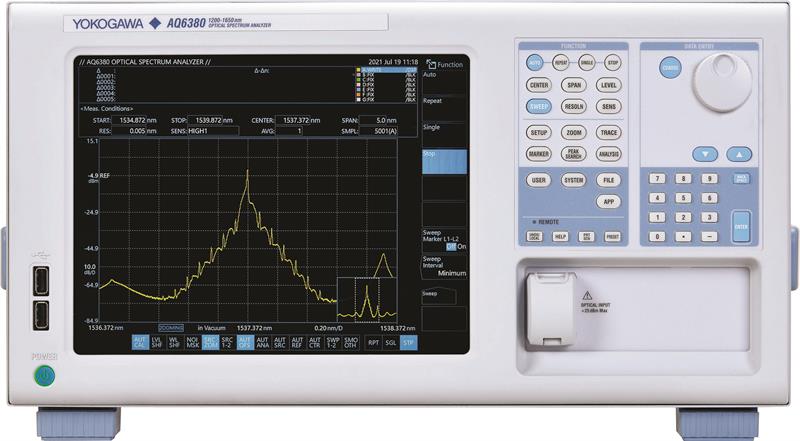Driven by the exponential growth in the Internet of Things, as well as cloud computing services, video broadcasting and conferencing, and the rise in access to mobile broadband, demand for data capacity is expected to expand hugely over the next few years. As a consequence, high capacity optical backhaul networks will be needed to serve this growing traffic density. Dense wavelength division multiplexing (DWDM) is an optical multiplexing technology used to increase bandwidth over the existing fiber network.
As applications push the performance requirements of DWDM systems, telecommunication channels will become ever more closely spaced, making it more difficult to separate the individual channels in the wavelength division multiplexing (WDM) analysis on an OSA.
The Yokogawa AQ6380 OSA has been designed to address this and its strong optical performance will allow users to develop and improve the speed, bandwidth and quality of the next generation of communication networks.
“The AQ6380 is demonstrably the world’s best grating based OSA, outperforming its nearest competing solution on wavelength accuracy, resolution, dynamic range, and actual measurement speed,” said Terry Marrinan, Yokogawa Test & Measurement’s Vice President, Marketing. “It also offers a highly capable alternative to other measurement technologies, comparing favorably on wavelength range and actual dynamic range, and offering superior measurement speed and application adaptability."
The AQ6380 has optical wavelength resolution down to 5 picometers (pm), allowing optical signals in close proximity to be clearly separated and accurately measured. With the AQ6380, waveforms that were previously not even visible in a typical OSA, such as modulation side peaks in the laser spectrum, can now be accurately visualized.

It also offers a wavelength range of 1200 to 1650 nm, allowing one unit to meet diverse wavelength measurement needs. With the ability to alter the wavelength resolution from 5 pm to 2 nm, a wide range of applications can be supported, from narrowband peak/notch measurements to wideband spectral measurements.
To maintain consistently high accuracy, the AQ6380 features on board calibration based on a built-in light source. Wavelength calibration is automatically performed at set intervals by switching the optical path with an internal optical switch.
Another important parameter in optical waveform analysis is close-in dynamic range, defined as the difference in power level measured from the peak of the signal to the noise at a specific distance from the peak wavelength.
The AQ6380 features a newly designed monochromator with sharper spectral characteristics than previously available, achieving a close-in dynamic range of up to 65 dB. The result is that signals in close proximity can be clearly separated and accurately measured. The monochromator also offers very high stray light suppression, an important criterion in optical measurement.
Fast measurement speed is another major benefit, with the AQ6380 capturing data points in only 0.23 seconds compared to 5.4 seconds for the existing model (AQ6370D) in certain conditions.
The AQ6380 has also been designed for ease and efficiency of use, ensuring the measurement scheme can be set up rapidly and data can be acquired easily. The high-resolution, responsive 10.4-inch touchscreen LCD makes the device as easy and intuitive to operate as a tablet.
When it comes to analyzing results, the AQ6380 has built-in analysis functions to characterize optical spectrum from a variety of optical systems and devices, such as WDM system, DFB-LD, EDFA, and filters.
Analysis functions include: DFB-LD; FP-LD; LED; Spectral width (peak/notch); SMSR; Optical power; WDM (OSNR); EDFA (Gain and NF); Filter (peak/bottom) and WDM filter (peak/bottom).
The AQ6380 also features an application menu “APP mode”, which makes measurement set-up much easier. Pushing the APP button brings up an overview of the pre-installed testing apps – WDM, DFB-LD, FP-LD and LED testing. A guide through wizard leads the user through an easy set up process for specific measurements and analysis.













